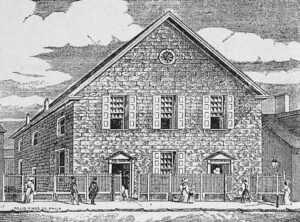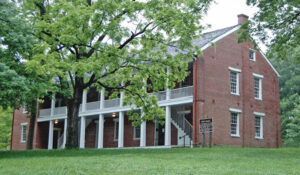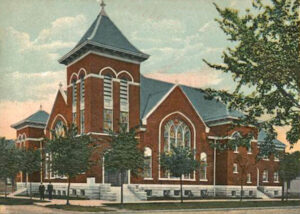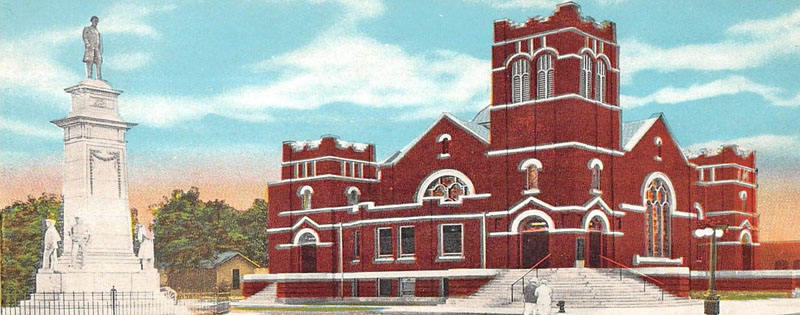
First Methodist Church in Hutchinson, Kansas.
John Wesley established the Methodist Episcopal Church organization in England while studying at Oxford. A few students of religious inclination became associated in 1729 and were called by the other students of the university Methodists or the Club of Saints, and by 1735, became known as the Oxford Methodists. The community formed by Charles and John Wesley retained the Anglican church’s form, organization, and rituals. However, it differed from the others in requiring fasts, special prayers, reading of the Bible, and frequent communions. The Methodists desired separation from the established church and were not formally cut off until forced to do so by the Orthodox ministers.
The Methodist church in America was first established in the colony of Georgia under James E. Oglethorpe, who returned from a trip to England in 1736 with 300 emigrants, among them John and Charles Wesley, the former having come to America to be not only a missionary among his fellow countrymen but also to carry the Gospel to the Indians, while Charles acted as secretary to Governor Oglethorpe. Difficulties arose between the colonial authorities, and John Wesley determined to return to England and lay the whole matter before Governor Oglethorpe. Although he never returned to America, the seeds he had planted grew and, in future years, bore much fruit. Soon after his departure, George Whitefield arrived in Philadelphia, Pennsylvania, and began to preach the Methodist doctrine. Philip Embury arrived in New York City from England in 1760 with a party of protestants, a few of whom were avowed Methodists. Before coming to America, he had served as a local Wesley preacher, but he did not hold any services in America until 1766, and from that time, Methodism began to flourish. Embury was a successful leader who organized societies on Long Island and Trenton, New Jersey, and Captain Webb, a convert, established Methodist congregations in Philadelphia and Wilmington. The church was first started in Maryland by Robert Strawbridge, from Ireland, who settled in Frederick County. The first conference was held in Philadelphia on July 11, 1773, and by 1774, the number of preachers had reached 17 and the number of members over 2,000.
In 1787, the colored people of Philadelphia belonging to different Methodist organizations became dissatisfied and withdrew from the church, and a colored preacher was ordained for them. This began the movement, resulting in African Americans organizing an independent body with the same doctrine and standards as the Methodist Episcopal church. They held the first conference in 1816, when the African Methodist Episcopal church was formed. Since that time, many different Methodist organizations have been started. Early in the 1840s, the church was divided on the question of slavery. In 1844, the Southern churches withdrew from the jurisdiction of the general conference, deciding upon a separate organization to be known as the Methodist Episcopal church, South. In 1860, the Free Methodist church was organized in New York, with slight modifications of the articles of the Methodist church and some changes in the form of government. Other branch organizations have been perfected until today. The original Methodists are divided into the following churches: Methodist Episcopal, Union American Methodist Episcopal (Colored), African Methodist Episcopal, and African Union Methodist Episcopal. African Methodist Episcopal Zion, Methodist Protestant, Wesleyan Methodist Connection America, Methodist Episcopal Church, South, Congregational Methodist, New Congregational Methodist, Colored Methodist Episcopal, Reformed Zion Union Apostolic (Colored), Primitive Methodist Episcopal, Free Methodist North America, and Reformed Methodist Union Episcopal (Colored).
The first work of the Methodist church in Kansas started when the region was an unorganized Indian Territory. At the Missouri conference held in St. Louis, Missouri, on September 16, 1830, action was taken concerning the mission work among the Indian tribes of Kansas. A society was formed, the constitution of which set forth that “The members of the Missouri conference, considering the great necessity for missionary exertions, and feeling a willingness to aid in the great work of sending the Gospel among all people, formed themselves into a missionary society of the Methodist Episcopal church.”
The first missionary appointments of 1830 read: “Shawnee Mission, Thomas Johnson, Kansas or Kaw Mission, William Johnson.” A little later, missions were formed among the Delaware, Peoria, Ioway, Sac, and Fox. When the Methodist church was divided on the question of slavery, the Indian Missions of Kansas fell to the Southern branch. One of the last Indian missions was established among the Wyandot in April 1844, resulting in one of Kansas’s earliest permanent Methodist organizations. The actual mission work of the Methodist church among the Kansas Indians ceased in 1854. These Indian missions were nearly all in what is now the eastern part of the State of Kansas. A few missions were maintained until the Indians were moved to the Indian Territory (Oklahoma.)
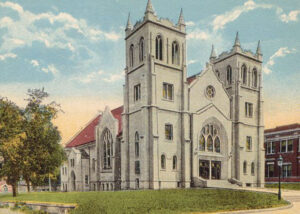
The United Methodist Church congregation in Leavenworth is the oldest in Kansas, getting its start in 1854.
In Douglas County, the first religious services of the Methodist Episcopal church were held by W.H. Goode at Lawrence in December 1854. A class was organized in the early spring of 1855 but was soon disbanded. In July, a permanent Methodist organization was perfected by L.B. Dennis and a tent was used for services until rooms were secured for the winter. A year or so later, a church was erected. The first Methodist services in Shawnee County were held at Tecumseh in October 1854 by J. B. Stateler, who soon erected a church building. On October 8, 1854, the first Methodist sermon was preached at Leavenworth. However, no church organization was formed until 1857, when a charter was obtained from the state legislature for a regular organization, and M.M. Harm was its first pastor. A church building was completed by 1861. Fort Scott was first established in Bourbon County as a government military post, and religious services were held there while it was a garrison, but no organization was perfected until 1855. C.E. Rice preached in Allen County early in 1856, and a church was established at Humboldt in 1860. One of the first ministers in Atchison County was James Shaw, who came to Kansas Territory in the spring of 1857 and delivered a sermon in Samuel Pomeroy’s office at Atchison in May. In October of that year, the Methodist Episcopal Church, South, was regularly organized there, and a building was erected. The Methodist Episcopal church, South, was organized at Doniphan, Doniphan County, in 1856, and though this organization erected no church, services were held at different points for some time. The first Methodist church was established at Doniphan on May 10, 1857, and a church building was erected early in the 1860s. The Methodists in Miami County were organized in the summer of 1858 at Paola by M.M. Pugh. They formed part of the Stanton circuit until 1864 when the church became an independent organization and erected a building in 1865. The first meetings in Ottawa, Franklin County, were held in the spring of 1866 by Mr. Adams, and in 1867, the Kansas conference sent the first accredited preacher. Johnson County had early Indian missionaries, but the first regular church was organized in Olathe in 1868.
As new settlements were formed, the outlying districts were served by Methodist circuit riders, who rode through the nearly unbroken wilderness and organized congregations. The Methodists were among the first denominations in Kansas and, in 1906, had the strongest in numbers, with a total membership of over 121,000, or more than 26% of the membership of all the churches.
Compiled and edited by Kathy Alexander/Legends of Kansas, updated February 2025.
About the Article: The text in this article comes from Kansas: A Cyclopedia of State History, edited by Frank W. Blackmar and published in 1912. However, the story as it appears here is not verbatim, as it has been edited for clarity and the modern reader.
Also See:

